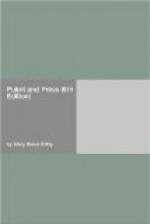The vestibule is a fitting entrance to this magnificent temple. In the ceiling is a sunburst with a seven-pointed star, which illuminates it. From this are the entrances leading to the auditorium, the “Mother’s room,” and the directors’ room.
The auditorium is seated with pews of curly birch, upholstered in old rose plush. The floor is in white Italian mosaic, with frieze of the old rose, and the wainscoting repeats the same tints. The base and cap are of pink Tennessee marble. On the walls are bracketed oxidized silver lamps of Roman design, and there are frequent illuminated texts from the Bible and from Mrs. Eddy’s SCIENCE AND HEALTH WITH KEY TO THE SCRIPTURES impaneled. A sunburst in the centre of the ceiling takes the place of chandeliers. There is a disc of cut glass in decorative designs covering 144 electric lights in the form of a star, which is twenty-one inches from point to point, the centre being of pure white light, and each ray under prisms which reflect the rainbow tints. The galleries are richly paneled in relief work. The organ and choir gallery is spacious and rich beyond the power of words to depict. The platform—corresponding to the chancel of an Episcopal church—is a mosaic work, with richly carved seats following the sweep of its curve, with a lamp stand of the rennaissance period on either end, bearing six richly wrought oxidized silver lamps, eight feet in height. The great organ comes from Detroit. It is one of vast compass, with aeolian attachment, and cost $11,000. It is the gift of a single individual—a votive offering of gratitude for the healing of the wife of the donor.
The chime of bells includes fifteen, of fine range and perfect tone.
THE “MOTHER’S ROOM.”
The “Mother’s room” is approached by an entrance of Italian marble, and over the door in large golden letters on a marble tablet, is the word “Love.” In this room the mosaic marble floor of white has a Romanesque border and is decorated with sprays of fig leaves bearing fruit. The room is toned in pale green with relief in old rose. The mantel is of onyx and gold. Before the great bay window hangs an Athenian lamp over two hundred years old, which will be kept always burning day and night. Leading off the “Mother’s room” are toilet apartments, with full length French mirrors and every convenience.




